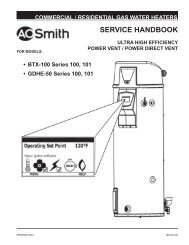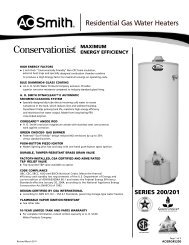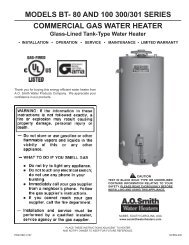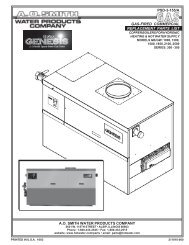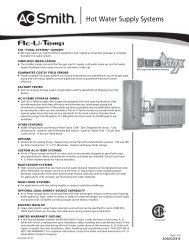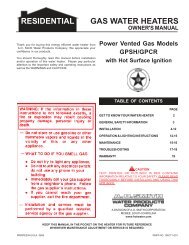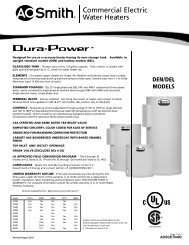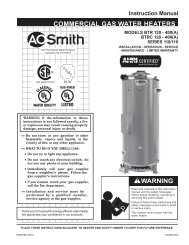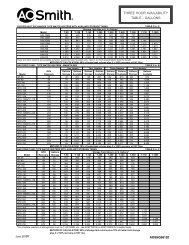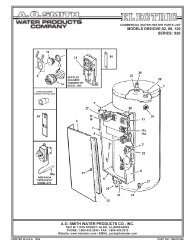Non-Condensing Models - AO Smith Water Heaters
Non-Condensing Models - AO Smith Water Heaters
Non-Condensing Models - AO Smith Water Heaters
You also want an ePaper? Increase the reach of your titles
YUMPU automatically turns print PDFs into web optimized ePapers that Google loves.
6| PageTroubleshooting Guide4. INSTALLATION1. Follow all local codes, or in the absence of local codes, follow the most recent edition of theNational Fuel Gas Code: ANSI Z223.1/NFPA 54 in the USA or CAN/CSA B149.1 Natural Gas,Propane Installation Code in Canada.2. All gas water heaters require careful and correct installation to ensure safe and efficientoperation. This manual must be followed exactly. Read the “Safety Guidelines” section in theinstallation manual.3. The manifold gas pressure is preset at the factory. It is computer controlled and should notneed adjustment.4. Maintain proper space for servicing. Install the unit so that it can be connected or removedeasily. Refer to the Clearances Section on p. 8 in the installation manual for proper clearances.5. The water heater must be installed in a location where the proper amount of combustible airwill be available to it at all times without obstructions.6. The electrical connection requires a means of disconnection, to terminate power to the waterheater for servicing and safety purposes.7. Do not install the unit where the exhaust vent is pointing into any opening in a building or wherethe noise may disturb your neighbors. Make sure the vent termination meets the requireddistance by local code from any doorway or opening to prevent exhaust from entering abuilding.8. Particles from flour, aerosols, and other contaminants may clog the air vent or reduce thefunctions of the rotating fan and cause improper burning of the gas. Regularly ensure that thearea around the unit is dust‐ or debris‐free; regular maintenance is recommended for thesetypes of environment.9. If you will be installing the water heater in a contaminated area with a high level of dust, sand,flour, aerosols or other contaminants/chemicals, they can become airborne and enter and buildup within the fan and burner causing damage to the water heater.10. For the Indoor 110 (T‐KJr2‐IN), 310 (T‐K4‐IN), and 510 (T‐D2‐IN) models:• These units may be converted to a direct‐vent (sealed combustion) appliance by installing adirect‐vent conversion kit (Part No. 9007667005) which will bring in all requiredcombustible air from outside the building. When installing the conversion kit, please followall instructions included with the kit.• If the water heater is used as a direct‐vent appliance, the unit requires a 3” intake air pipe.The intake pipe must be sealed airtight. Air supply pipe can be made of ABS, PVC,galvanized steel, corrugated aluminum, corrugated stainless steel or Category III stainlesssteel.• Terminating the venting through a sidewall is recommended for the direct‐vent system.• Running the exhaust vent and the intake pipe parallel is recommended.• Terminating the exhaust and intake on the same wall / surface is recommended.Terminating in the same pressure zone allows for pressure balancing, which preventsnuisance shutdowns. Follow venting clearance guidelines in the installation manual.11. For Outdoor 110 (T‐KJr2‐OS), 310 (T‐K4‐OS), & 510 (T‐D2‐OS):• To be installed outdoors and only in areas with mild, temperate climates.



